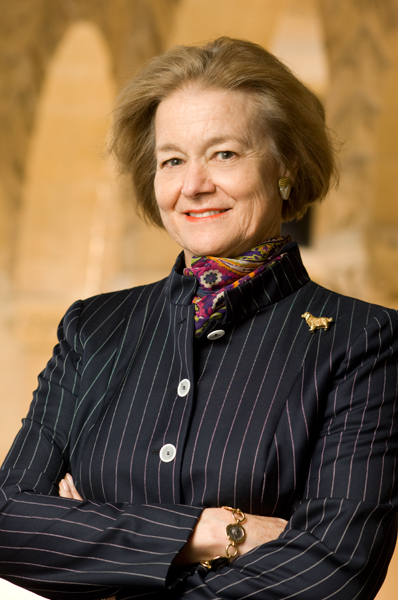
Message from the Chair of the Board of Trustees
This year marks the 125th anniversary of Stanford’s founding, a milestone that has prompted me to consider the university’s origins and reflect on its development.
In November 1885 Jane and Leland Stanford executed the university’s Founding Grant even as they struggled with the devastating loss of their only child. They looked beyond their personal grief and envisioned a future profoundly hopeful.
Their aspirations for the university were clear from the beginning: Established as a tribute to their son, the Leland Stanford Junior University was to be a “University of high degree.” In the Founding Grant’s 11 pages and little more than 3,000 words, the Stanfords articulated the foundational beliefs that have shaped — and continue to shape — Stanford University more than a century later.
The first article states the university’s purpose: to educate students “for personal success, and direct usefulness in life” and “to promote the public welfare by exercising an influence in behalf of humanity and civilization.” This clarion call for practical education in service to society has forged Stanford University.
From the earliest days, we have educated our students to put their knowledge to good use, and we see that tradition at work today in our multidisciplinary initiatives. Through these we are tackling society’s most difficult problems from many disciplines and directions — pioneering advances in regenerative medicine, seeking new approaches to K-12 education, finding ways to alleviate poverty and developing sustainable energy technologies, just to name a few of our path-breaking ventures.
These efforts are built on the strong foundation of a liberal education, one that includes, as the Stanfords stipulated, “studies and exercises directed to the cultivation and enlargement of the mind.” The Founding Grant affirms the importance of the arts in this process, recognizing that museums and art galleries are “necessary and appropriate to a university of high degree.” Today, the arts are flourishing here, reflecting our deep commitment to nurturing creativity in our students and the recognition of the many ways in which the arts contribute to the Stanford experience and stimulate the spirit of innovation and discovery that permeates this campus.
The Founding Grant also describes the university’s physical plant, declaring that the buildings should be “substantial in character” and “allow for additions and expansions.” At the same time the Stanfords reminded the Trustees that it is the quality of the faculty and students, not its buildings, that determines a university’s excellence.
As President Hennessy noted in his opening essay, we dedicated a number of buildings this year — each designed to enable the work of the university’s faculty and students and accommodate their needs today and tomorrow. These superb additions to our physical plant reflect the founders’ pioneering spirit, even as they embody our commitment to research and education that benefits society.
In addition to their vision of an education linked to service to society, Jane and Leland Stanford believed that education should be accessible to “the deserving and exceptional.” Although the university charged no tuition in its early years, the Founding Grant included a provision for scholarships.
Today, we continue to honor that commitment. As we enter the final year of The Stanford Challenge, we are focused on investing in our students and faculty — sustaining our financial aid program, providing fellowships to outstanding graduate students and retaining our distinguished faculty.
Our alumni and friends share our belief in this work, and the excellence of Stanford University is a testament to their deep commitment and support. Their continued generosity is evidence of the strength of the Stanford community and the bonds that connect generations.
The Founding Grant is an extraordinary document, the source for the university’s development as we move forward in this century. Over the years, it has guided and inspired, prompting each generation to strike out in new directions.
In a letter to the Board of Trustees on July 6, 1904, Jane Stanford wrote:
“Through all these years, I have kept a mental picture before me. I could see a hundred years ahead when all the present trials were forgotten, and all of the present active parties gone, and nothing remaining but the institution. I could see beyond all this the children’s children’s children coming here from the East, the West, the North, and the South.”
Now — more than a hundred years ahead — Stanford University exemplifies that vision. Looking forward, I have no doubt that Stanford will remain true to its founding spirit, attracting exceptional students and faculty from all corners of the world, to advance the cause of humanity. Thank you for your support for this remarkable university.
Leslie P. Hume
Chair,
Stanford University Board of Trustees

